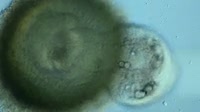Liver fluke. A juvenile liver fluke (Fasciola hepatica), emerging from its metacercarial cyst. This parasitic trematode (flatworm) infects the livers of various mammals, including humans, causing a disease known as fascioliasis. Metacercarial cysts attached to vegetation are ingested by ruminants, or by humans eating uncooked foods such as watercress. In the duodenum, immature flukes emerge and migrate into the bile ducts, feeding on blood and tissue. They mature and lay eggs which contaminate water via the host's faeces. The eggs hatch and infect certain freshwater snails from which larvae later emerge. The larvae form metacercarial cysts on nearby vegetation, thus continuing the fluke's life cycle. Footage filmed at Ridgeway Research, Gloucestershire, United Kingdom.
Details
WebID:
C01840945
Clip Type:
RM
Super High Res Size:
1920X1080
Duration:
00:00:39.000
Format:
QuickTime
Bit Rate:
23 fps
Available:
download
Comp:
200X112 (0.00 M)
Model Release:
NO
Property Release
No













 Loading
Loading